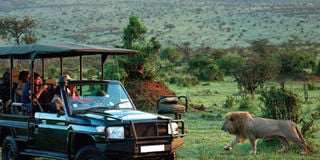How safe are you in the game park?

Tourists take photos of a lion in a game park. Tourists are advised to uphold the proximity code by staying at a safe distance from the animals while taking their photos, the closest being seven metres
What you need to know:
Wild contact. Did you know that even a simple issue like the choice of the colour your dress can determine your safety in the park?
On Monday, a 22-year-old American woman was just another tourist in the Gauteng Lion Park on the outskirts of Johannesburg, South Africa. Coiled at the back of her SUV, camera in hand and in the company of a male local tour guide as her driver, she twisted the lens, clicked, snapped, and snapped some more—just another lion enthusiast capturing her rare moment in the company of the big cats.
Taking keen interest in a particular nine-year-old lioness, and perhaps because the Gauteng Lion Park’s website guarantees “super close-up animal views,” she kept getting nearer to the lioness. Even with the windows to the car rolled down, she still moved in for a closer shot, getting dangerously close. Witness accounts confirm that at one point, she was taking pictures of the animal from just a metre away!
And then it happened—the lioness attacked through the window and furiously attempted to drag the woman out of the car, biting her in the process. The driver, who valiantly fought off the lion, was also badly injured. Shortly after the attack, paramedics were already at the scene. But for the young woman, she had got too close to the animal and paid dearly, with her life.
Are you safe in the park?
This is a very unfortunate turn of events by all standards, but one that brings a very important question to mind, are we safe in the park? Well, the answer is no, at least according to Samuel Makanga, the executive director Prime Safaris and Tours.
“Do not even dare imagine you are completely safe in the park with hundreds of potentially dangerous animals out there on the loose, because you are not. And the authorities are well aware of the dangers in the parks. That is why we always have safety standards and measures. Those who follow them can claim to be on the safe side,” Makanga reveals.
In his view, much as the danger posed by different animals varies, all animals can actually be dangerous. Of course, the cat family is the usual suspect when it comes to park attacks. This includes lions, leopards, cheetahs and tigers. But as Makanga shares, “Even the somewhat peaceful animals such as elephants, baboons, mountain gorillas and buffalos can be very dangerous if one is not careful, and for sure, some tourists are not because clearly, most of the incidents in which the animals have attacked tourists are caused by the reluctance of visitors to stick to the laid out script in regards to the safety code of conduct.”
The mistakes we make in the park
According to Simon Peter Sima, a tour consultant at Wild Gorilla Safaris, a number of people make major mistakes while in the park, but perhaps the common errors arise at the point of taking pictures. And it is the distance at which you stand to get the shot that Sima warns most about.
“There are cases where people insist on standing too close to the animal to take pictures. The danger here is that most cameras make that disturbing sound every time they click. Plus, sometimes people leave the flash on, and all these, together with the constant twisting and turning as one positions themselves for the picture, creates the kind of environment that animals find threatening. And just because you are a metre away, the animal will not hesitate to violently get you off its case,” Sima explains. It is on this account that he implores people to turn the camera flash off and set a softer click sound. Most importantly though, tourists should uphold the proximity code by staying at a safe distance from the animals, the closest being seven metres.
Unfortunately, the proximity code is not only violated when taking pictures or watching, some tourists like so much to bond with the animals as they offer them food, and have in rare incidents gone ahead to pet them as they eat. Granted; petting the animals could be termed brave, but it is a sure way of putting one foot in your own grave! Sima does not advise anyone to pet the animals. And furthermore, you should not give the animals food.
“First of all, according to the Uganda Wildlife Authority, it is illegal to give animals food as sometimes such food may not be entirely safe. But it is not safe to you either because as you offer the food you, may unknowingly invite the animal closer or push further out into its circle and put yourself in harm’s way,” Sima shares.
Makanga highlights another common mistake as the reluctance of tourists not to roll up their windows when watching the animals. This, in his view, should be among the first safety precautions before you enter the park. “Make sure the windows to your car are rolled up. This is the reason you need to have clear windows. It is the people who enter parks with tinted car glasses that are usually tempted to lower them for a fine view, and the result could be fatal.”
Watch your dressing too. For many animals, but mostly for the case of mountain gorillas and baboons, you will have to pay attention to what you are wearing. Sima implores tourists not to go out to watch the animals in very bright colours as the primates may interprete it for attention-seeking, and apparently, seeking the attention of a big primate is the last thing you want to do.
“The mountain gorillas, for instance, are very peaceful and rarely attack tourists. But if you come closer than seven metres, which is the stipulated distance you ought to keep from it, and unfortunately catch its attention perhaps as a result of your yellow or pink T-shirt, or as a result of noise making, it will come fetch you” asserts Sima.
Makanga follows the same verbal stride to sound a bell of caution, advising ladies not to wear very colourful make-up. “Remember, the goal is to avoid catching the attention of the animal and very shiny make-up does not help in that regard. Also, for the case of gorilla watching, ladies should not dress so skimpily.”

Tourists have their breakfast in a bush at Semliki National Game Park
In what he dishes out as general advice to any tourist intending to visit a park, Sima implores all visitors to always read the safety measures for any particular park before embarking on the park rounds, and to follow such rules and guidelines.
Visitors should desist from getting out of their cars if the park guide dictated against it, or lowering their car windows if advised not to. “Also, avoid driving off track. Some tourists are given guidelines not to drive beyond particular boundaries. Unfortunately, the tourists push the guides to take them a little ahead just because they have seen a pack of animals they are interested in headed that way. That is how they drive into danger zones.
Uganda wildlife authority safety rules
• Do not camp or make campfires except at official sites.
• Do not drive off the tracks.
• Do not disturb the wildlife by sounding motor horns.
• Do not drive in the park between 7.30pm and 6:30 am.
• Do not bring pets to the park.
• Do not drop litter, especially cigarette ends or matches.
• Do not bring firearms or ammunition into the park.
• Do not pick flowers or destroy any vegetation.
• Do not exceed the speed limit of 40km per hour (25mph).
source: www.ugandawildlife.org




